Abstract
To characterize the role of the liver and kidney in the metabolic response to injury and infection, selective catheterization of the hepatic (42 veins) and renal veins (21 veins) was performed in 31 burn patients (mean burn size: 51% TBS), studied 4-129 days postinjury. Blood flow was determined by standard clearance techniques (ICG and PAH), and simultaneous arterial and hepatic and/or renal vein blood was obtained for oxygen, glucose, lactate, pyruvate, and amino acids. Patients studied in the first to third weeks postinjury were classified as noninfected (8 studies), bacteremic (8 studies), or bacteremic with complications (5 studies). There was no difference in age, weight, mean burn size, pulse rate, blood pressure, rectal temperature, total body oxygen consumption, or cardiac index among these groups. Estimated hepatic blood flow (EHBF) and hepatic substrate balance of these patients were compared with postabsorptive normal subjects in the literature (mean +/- SEM or range). :Formula: (See Text) Thermal injury alone resulted in marked increases in EHBF, hepatic oxygen uptake, and glucogenesis. The added insult of bacteremia significantly increased hepatic glucose output; as clinical sepsis progressed, glucose output decreased sharply. The kidney consistently demonstrated a net uptake of glucose in all studies. The changes in hepatic glucose output in bacteremic patients occurred without significant differences in EHBF, oxygen utilization or lactate uptake, but were associated with marked alterations in amino acid uptake.
Full text
PDF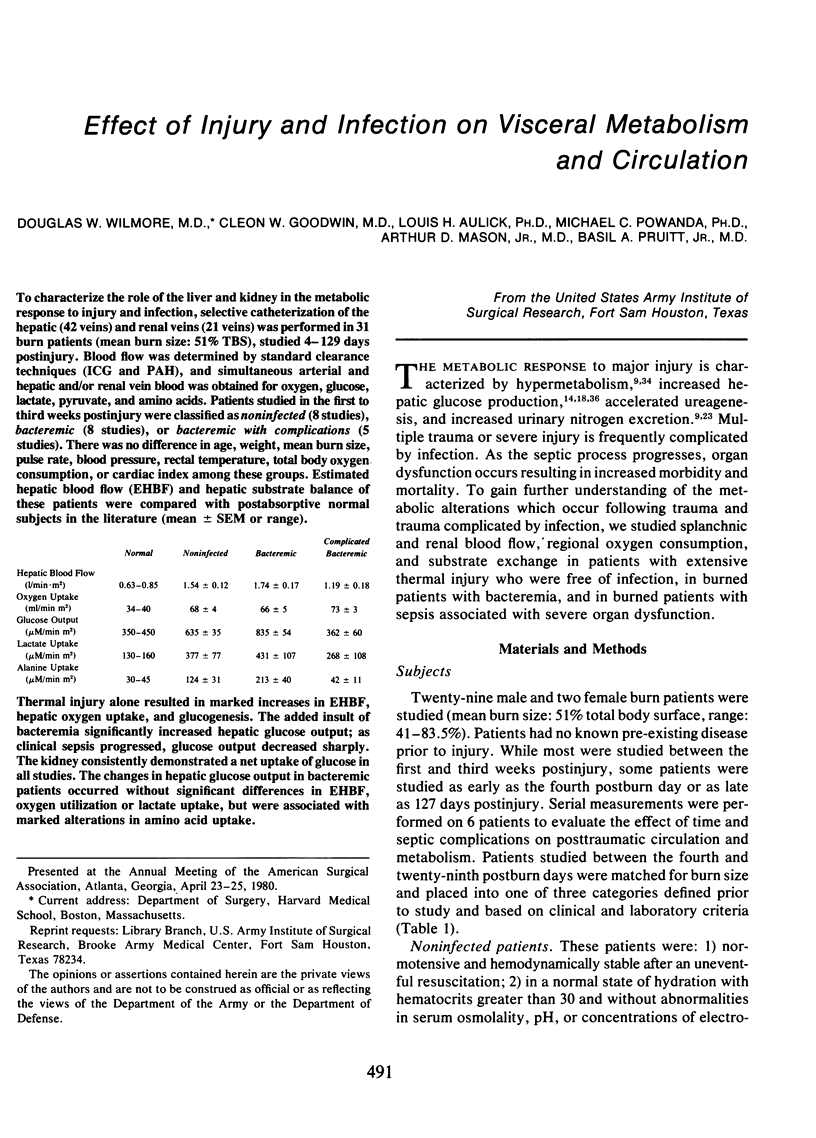
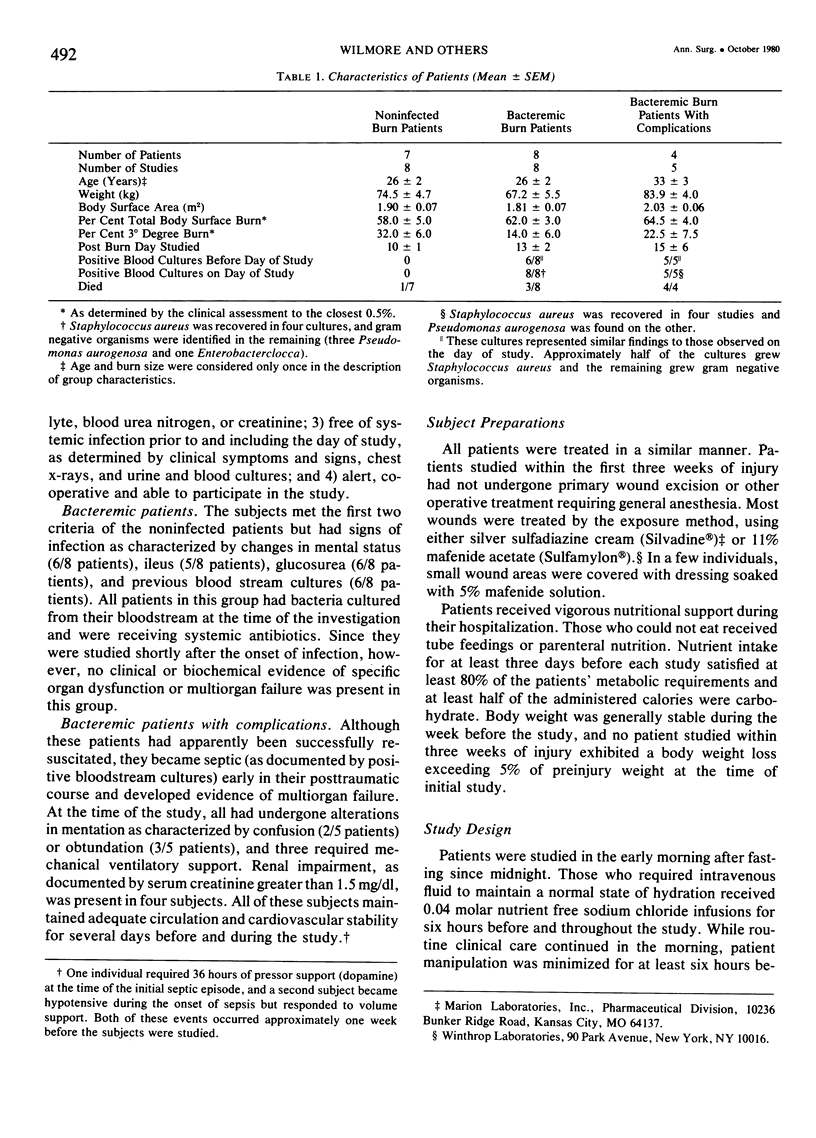
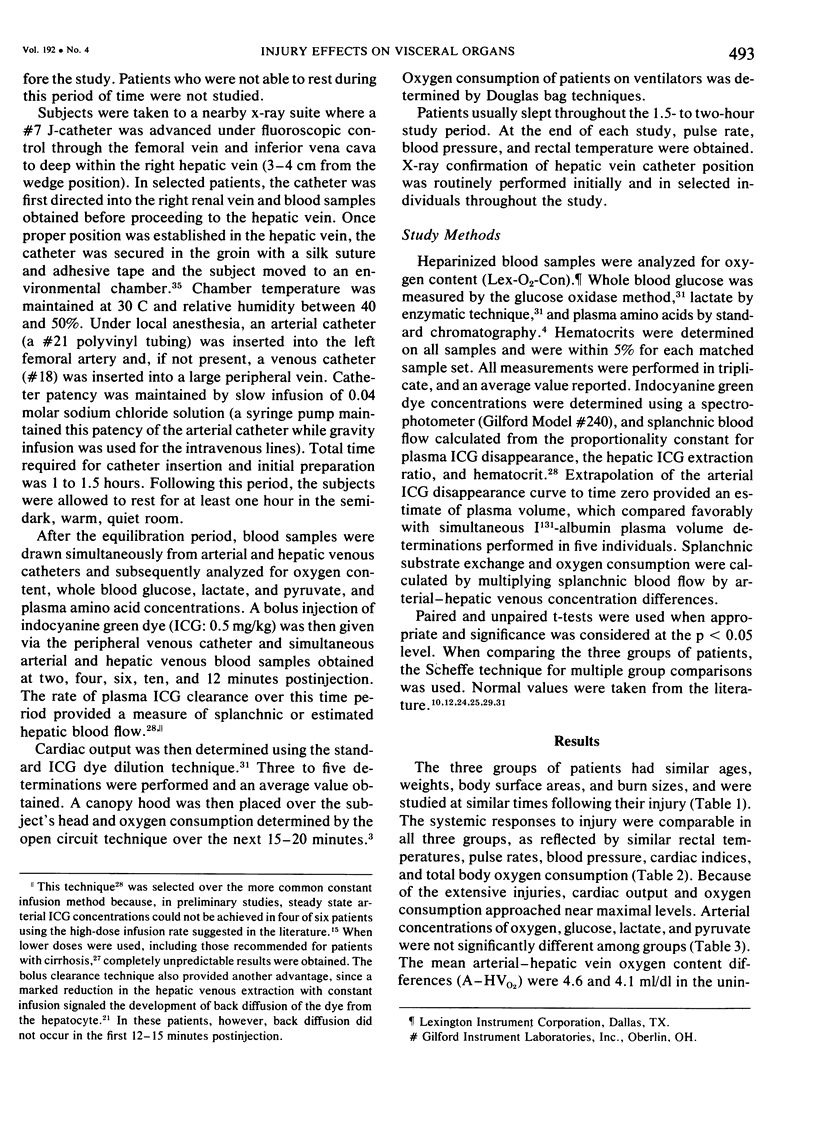

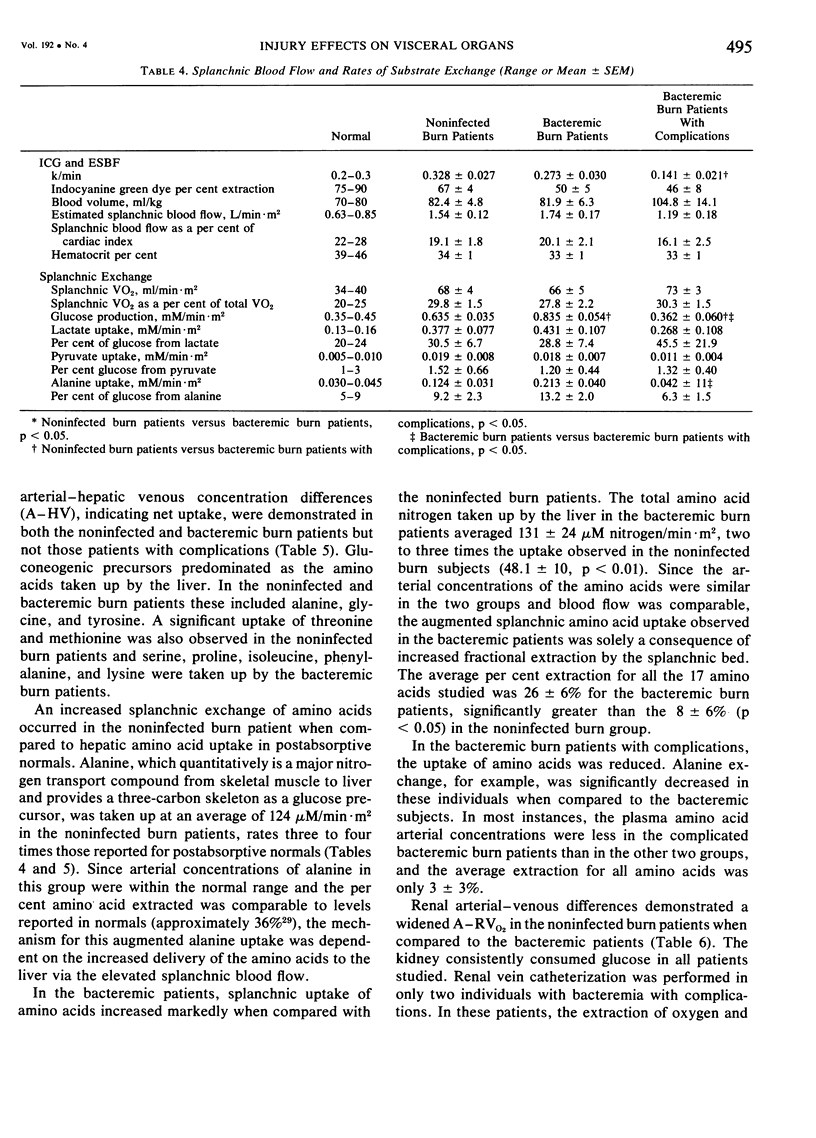
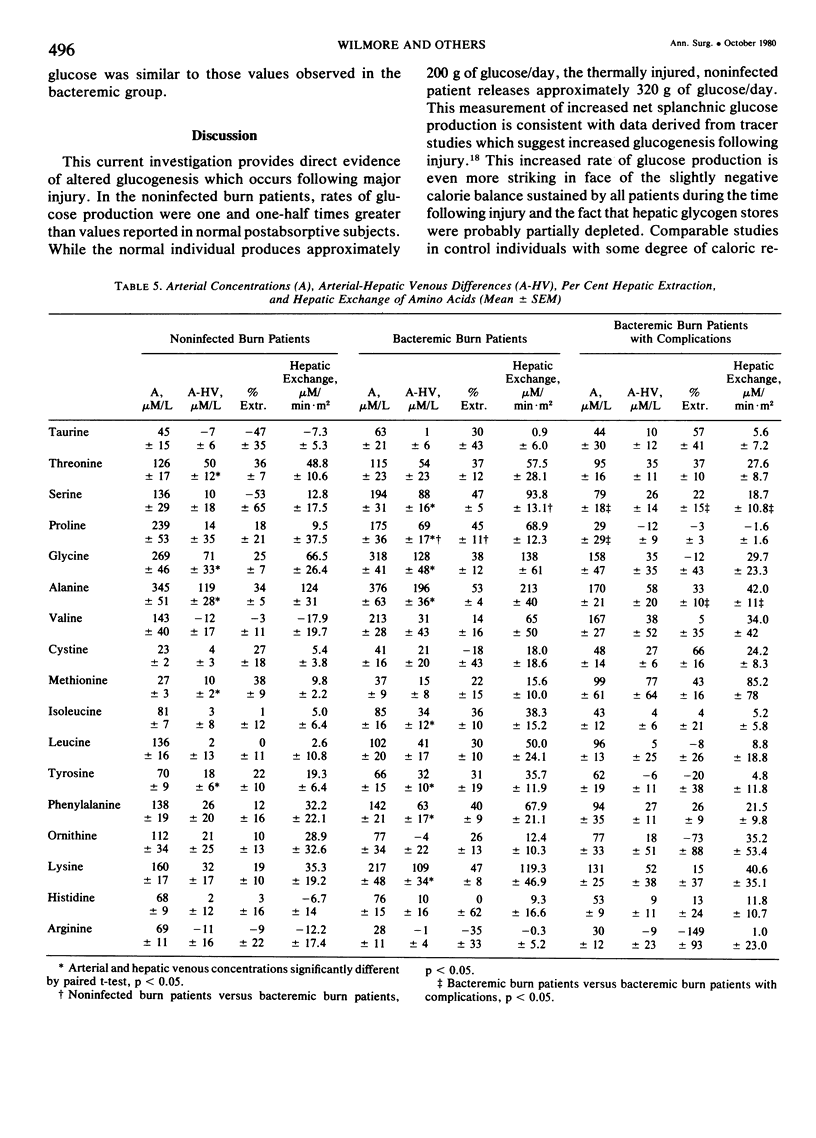

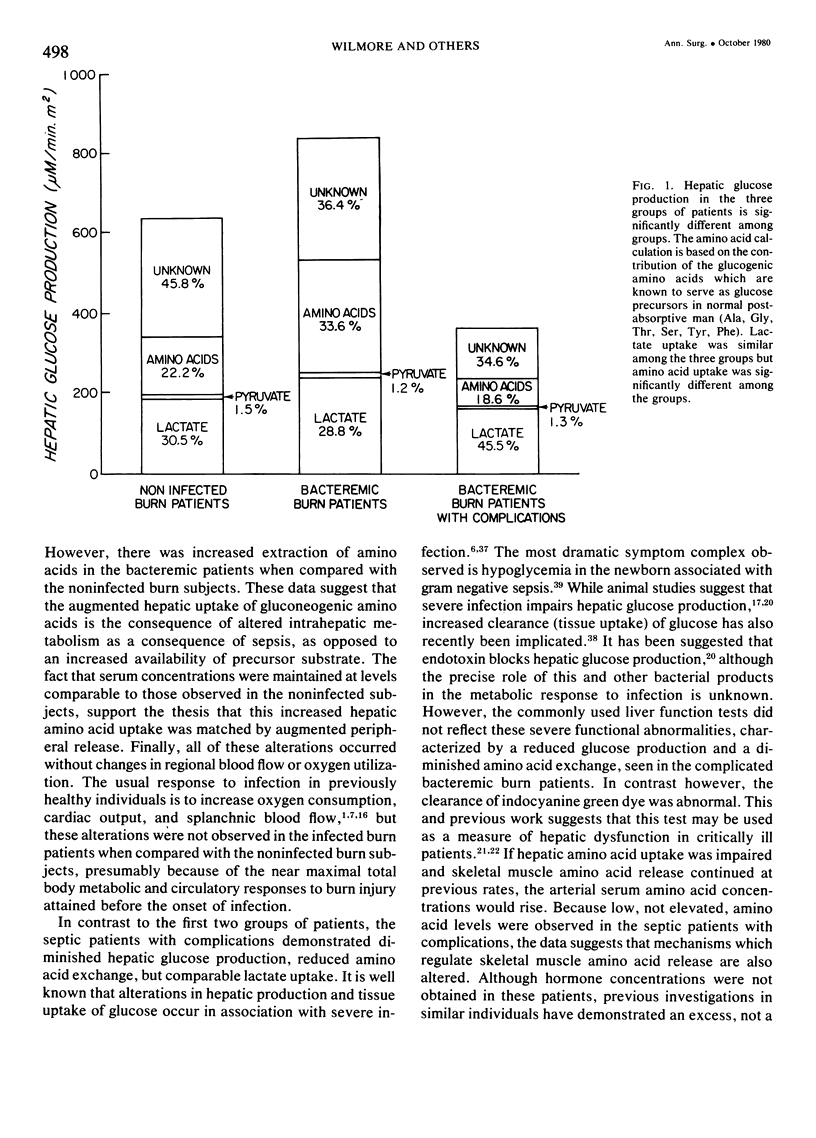
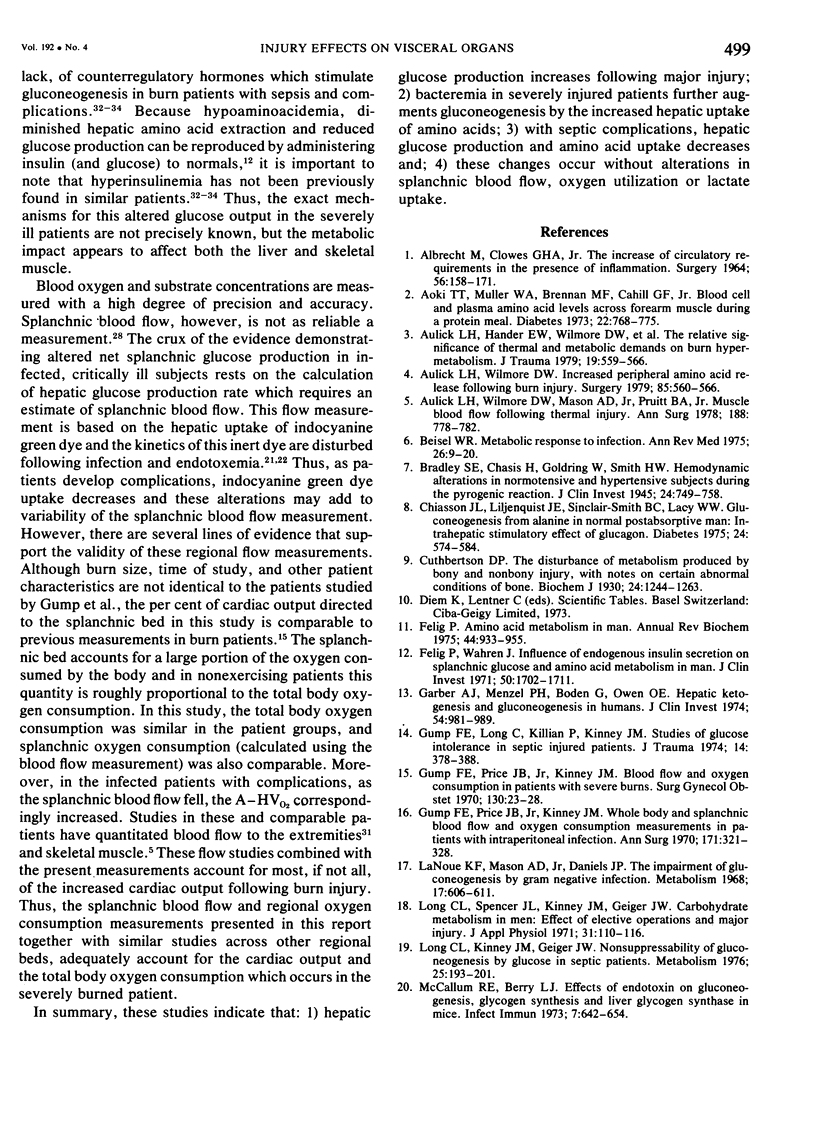
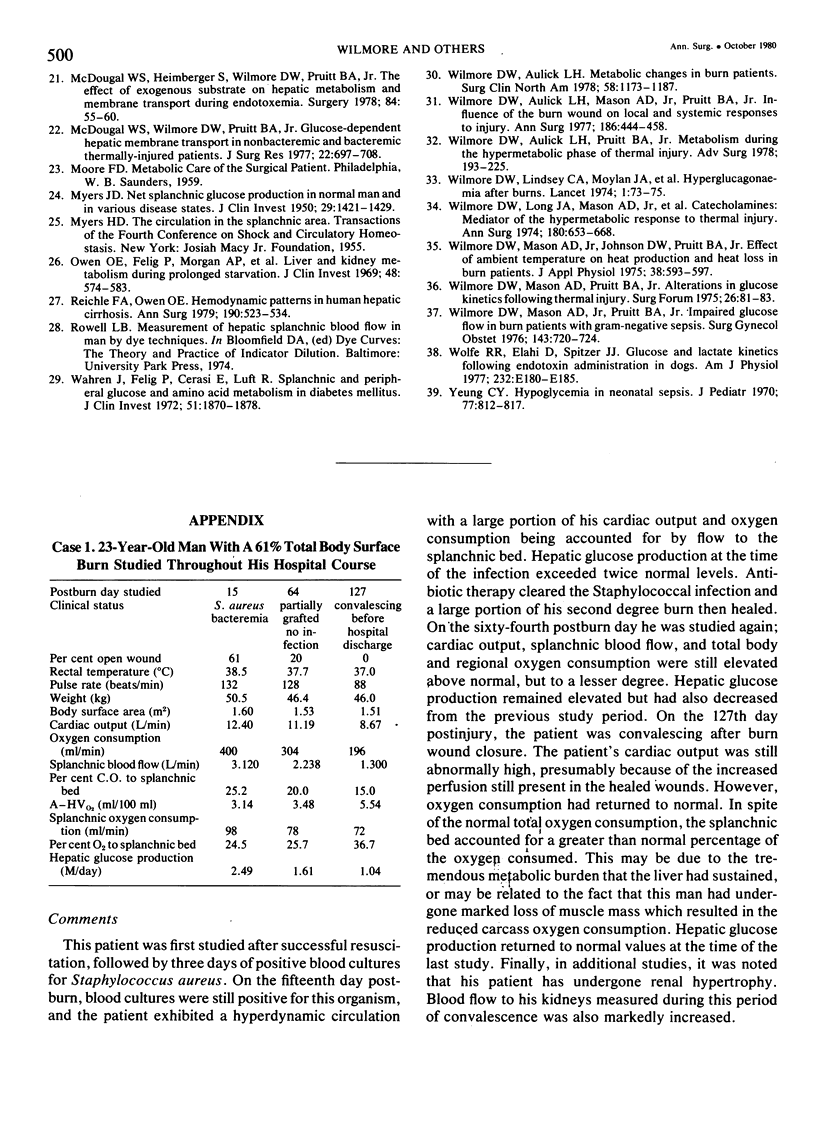
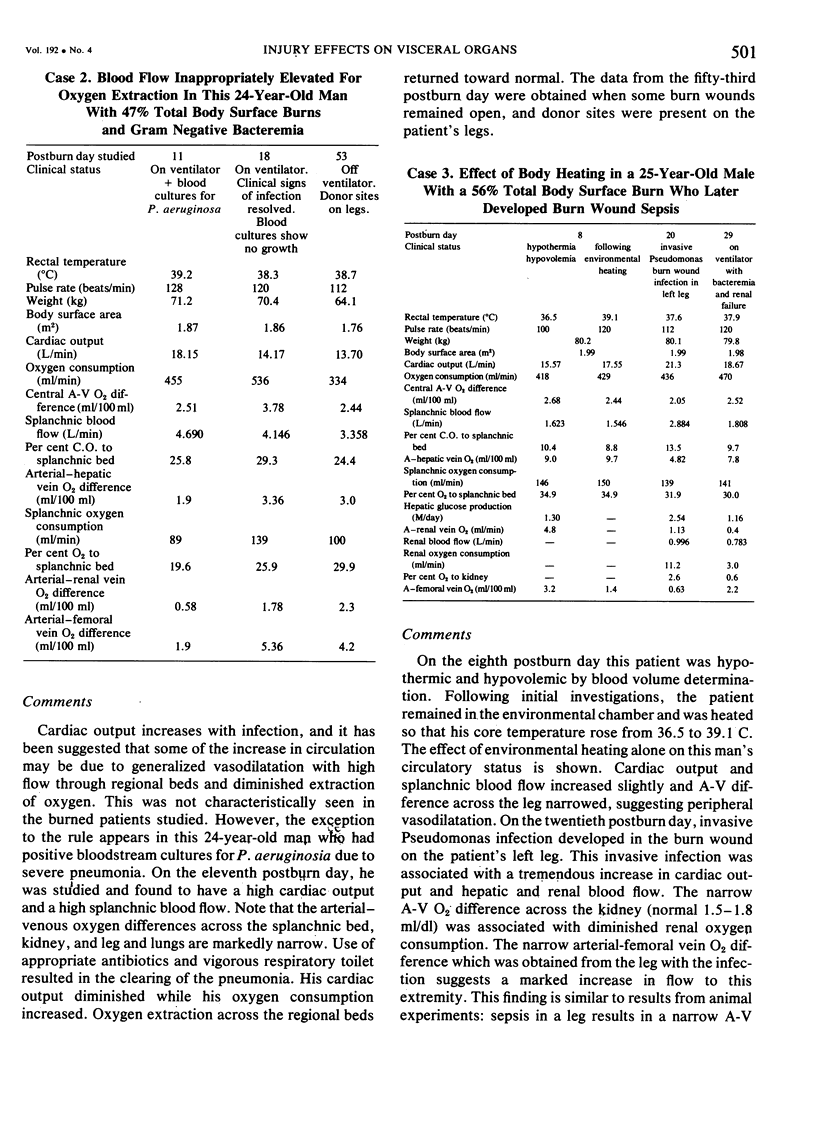
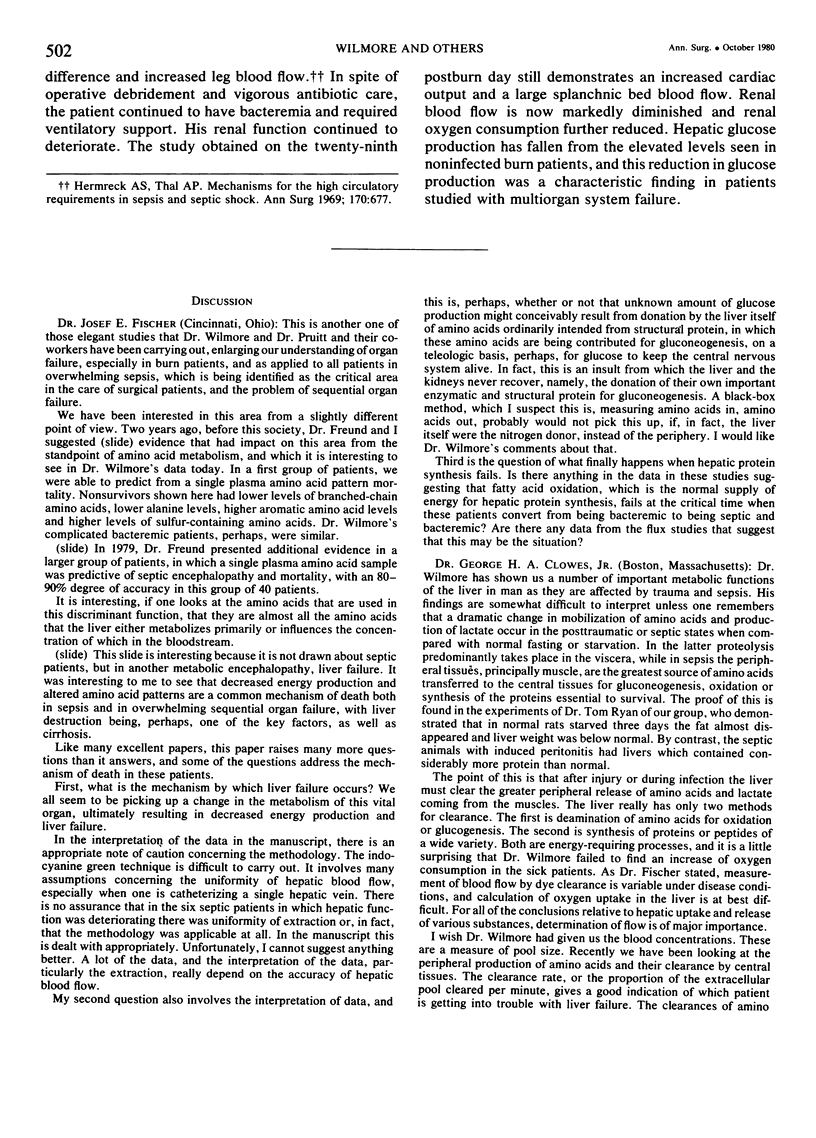
Selected References
These references are in PubMed. This may not be the complete list of references from this article.
- ALBRECHT M., CLOWES G. H., Jr THE INCREASE OF CIRCULATORY REQUIREMENTS IN THE PRESENCE OF INFLAMMATION. Surgery. 1964 Jul;56:158–171. [PubMed] [Google Scholar]
- Aoki T. T., Muller W. A., Brennan M. F., Cahill G. F., Jr Blood cell and plasma amino acid levels across forearm muscle during a protein meal. Diabetes. 1973 Oct;22(10):768–775. doi: 10.2337/diab.22.10.768. [DOI] [PubMed] [Google Scholar]
- Aulick L. H., Hander E. H., Wilmore D. W., Mason A. D., Jr, Pruitt B. A., Jr The relative significance of thermal and metabolic demands on burn hypermetabolism. J Trauma. 1979 Aug;19(8):559–556. doi: 10.1097/00005373-197908000-00003. [DOI] [PubMed] [Google Scholar]
- Aulick L. H., Wilmore D. W. Increased peripheral amino acid release following burn injury. Surgery. 1979 May;85(5):560–565. [PubMed] [Google Scholar]
- Aulick L. H., Wilmore D. W., Mason A. D., Jr, Pruitt B. A., Jr Muscle blood flow following thermal injury. Ann Surg. 1978 Dec;188(6):778–782. doi: 10.1097/00000658-197812000-00011. [DOI] [PMC free article] [PubMed] [Google Scholar]
- Beisel W. R. Metabolic response to infection. Annu Rev Med. 1975;26:9–20. doi: 10.1146/annurev.me.26.020175.000301. [DOI] [PubMed] [Google Scholar]
- Bradley S. E., Chasis H., Goldring W., Smith H. W. HEMODYNAMIC ALTERATIONS IN NORMOTENSIVE AND HYPERTENSIVE SUBJECTS DURING THE PYROGENIC REACTION. J Clin Invest. 1945 Sep;24(5):749–758. doi: 10.1172/JCI101660. [DOI] [PMC free article] [PubMed] [Google Scholar]
- Chiasson J. L., Liljenquist J. E., Sinclair-Smith B. C., Lacy W. W. Gluconeogenesis from alanine in normal postabsorptive man. Intrahepatic stimulatory effect of glucagon. Diabetes. 1975 Jun;24(6):574–584. doi: 10.2337/diab.24.6.574. [DOI] [PubMed] [Google Scholar]
- Cuthbertson D. P. The disturbance of metabolism produced by bony and non-bony injury, with notes on certain abnormal conditions of bone. Biochem J. 1930;24(4):1244–1263. doi: 10.1042/bj0241244. [DOI] [PMC free article] [PubMed] [Google Scholar]
- Felig P. Amino acid metabolism in man. Annu Rev Biochem. 1975;44:933–955. doi: 10.1146/annurev.bi.44.070175.004441. [DOI] [PubMed] [Google Scholar]
- Felig P., Wahren J. Influence of endogenous insulin secretion on splanchnic glucose and amino acid metabolism in man. J Clin Invest. 1971 Aug;50(8):1702–1711. doi: 10.1172/JCI106659. [DOI] [PMC free article] [PubMed] [Google Scholar]
- Garber A. J., Menzel P. H., Boden G., Owen O. E. Hepatic ketogenesis and gluconeogenesis in humans. J Clin Invest. 1974 Oct;54(4):981–989. doi: 10.1172/JCI107839. [DOI] [PMC free article] [PubMed] [Google Scholar]
- Gump F. E., Long C., Killian P., Kinney J. M. Studies of glucose intolerance in septic injured patients. J Trauma. 1974 May;14(5):378–388. doi: 10.1097/00005373-197405000-00004. [DOI] [PubMed] [Google Scholar]
- Gump F. E., Price J. B., Jr, Kinney J. M. Blood flow and oxygen consumption in patients with severe burns. Surg Gynecol Obstet. 1970 Jan;130(1):23–28. [PubMed] [Google Scholar]
- Gump F. E., Price J. B., Jr, Kinney J. M. Whole body and splanchnic blood flow and oxygen consumption measurements in patients with intraperitoneal infection. Ann Surg. 1970 Mar;171(3):321–328. doi: 10.1097/00000658-197003000-00001. [DOI] [PMC free article] [PubMed] [Google Scholar]
- LaNoue K. F., Mason A. D., Jr, Daniels J. P. The impairment of glucogenesis by gram negative infection. Metabolism. 1968 Jul;17(7):606–611. doi: 10.1016/0026-0495(68)90019-x. [DOI] [PubMed] [Google Scholar]
- Leeper H. A., Jr, Appl F. J. Lingual-palatal pressure measurement and analysis techniques. J Speech Hear Res. 1975 Sep;18(3):588–593. doi: 10.1044/jshr.1803.588. [DOI] [PubMed] [Google Scholar]
- Long C. L., Kinney J. M., Geiger J. W. Nonsuppressability of gluconeogenesis by glucose in septic patients. Metabolism. 1976 Feb;25(2):193–201. doi: 10.1016/0026-0495(76)90049-4. [DOI] [PubMed] [Google Scholar]
- Long C. L., Spencer J. L., Kinney J. M., Geiger J. W. Carbohydrate metabolism in man: effect of elective operations and major injury. J Appl Physiol. 1971 Jul;31(1):110–116. doi: 10.1152/jappl.1971.31.1.110. [DOI] [PubMed] [Google Scholar]
- MYERS J. D. Net splanchnic glucose production in normal man and in various disease states. J Clin Invest. 1950 Nov;29(11):1421–1429. doi: 10.1172/JCI102380. [DOI] [PMC free article] [PubMed] [Google Scholar]
- McCallum R. E., Berry L. J. Effects of endotoxin on gluconeogenesis, glycogen synthesis, and liver glycogen synthase in mice. Infect Immun. 1973 Apr;7(4):642–654. doi: 10.1128/iai.7.4.642-654.1973. [DOI] [PMC free article] [PubMed] [Google Scholar]
- McDougal W. S., Wilmore D. W., Pruitt B. A., Jr Glucose-dependent hepatic membrane transport in nonbacteremic and bacteremic thermally injured patients. J Surg Res. 1977 Jun;22(6):697–708. doi: 10.1016/0022-4804(77)90112-3. [DOI] [PubMed] [Google Scholar]
- Owen O. E., Felig P., Morgan A. P., Wahren J., Cahill G. F., Jr Liver and kidney metabolism during prolonged starvation. J Clin Invest. 1969 Mar;48(3):574–583. doi: 10.1172/JCI106016. [DOI] [PMC free article] [PubMed] [Google Scholar]
- Reichle F. A., Owen O. E. Hemodynamic patterns in human hepatic cirrhosis: a prospective randomized study of the hemodynamic sequelae of distal splenorenal (Warren) and mesocaval shunts. Ann Surg. 1979 Oct;190(4):523–534. doi: 10.1097/00000658-197910000-00012. [DOI] [PMC free article] [PubMed] [Google Scholar]
- Wahren J., Felig P., Cerasi E., Luft R. Splanchnic and peripheral glucose and amino acid metabolism in diabetes mellitus. J Clin Invest. 1972 Jul;51(7):1870–1878. doi: 10.1172/JCI106989. [DOI] [PMC free article] [PubMed] [Google Scholar]
- Wilmore D. W., Aulick L. H., Mason A. D., Pruitt B. A., Jr Influence of the burn wound on local and systemic responses to injury. Ann Surg. 1977 Oct;186(4):444–458. doi: 10.1097/00000658-197710000-00006. [DOI] [PMC free article] [PubMed] [Google Scholar]
- Wilmore D. W., Aulick L. H. Metabolic changes in burned patients. Surg Clin North Am. 1978 Dec;58(6):1173–1187. doi: 10.1016/s0039-6109(16)41685-3. [DOI] [PubMed] [Google Scholar]
- Wilmore D. W., Aulick L. H., Pruitt B. A., Jr Metabolism during the hypermetabolic phase of thermal injury. Adv Surg. 1978;12:193–225. [PubMed] [Google Scholar]
- Wilmore D. W., Lindsey C. A., Moyland J. A., Faloona G. R., Pruitt B. A., Unger R. H. Hyperglucagonaemia after burns. Lancet. 1974 Jan 19;1(7847):73–75. doi: 10.1016/s0140-6736(74)92290-9. [DOI] [PubMed] [Google Scholar]
- Wilmore D. W., Long J. M., Mason A. D., Jr, Skreen R. W., Pruitt B. A., Jr Catecholamines: mediator of the hypermetabolic response to thermal injury. Ann Surg. 1974 Oct;180(4):653–669. doi: 10.1097/00000658-197410000-00031. [DOI] [PMC free article] [PubMed] [Google Scholar]
- Wilmore D. W., Mason A. D., Jr, Johnson D. W., Pruitt B. A., Jr Effect of ambient temperature on heat production and heat loss in burn patients. J Appl Physiol. 1975 Apr;38(4):593–597. doi: 10.1152/jappl.1975.38.4.593. [DOI] [PubMed] [Google Scholar]
- Wilmore D. W., Mason A. D., Jr, pruitt B. A., Jr Impaired glucose flow in burned patients with gram-negative sepsis. Surg Gynecol Obstet. 1976 Nov;143(5):720–724. [PubMed] [Google Scholar]
- Wilmore D. W., Mason A. D., Pruitt B. A., Jr Alterations in glucose kinetics following thermal injury. Surg Forum. 1975;26:81–83. [PubMed] [Google Scholar]
- Wolfe R. R., Elahi D., Spitzer J. J. Glucose and lactate kinetics after endotoxin administration in dogs. Am J Physiol. 1977 Feb;232(2):E180–E185. doi: 10.1152/ajpendo.1977.232.2.E180. [DOI] [PubMed] [Google Scholar]
- Yeung C. Y. Hypoglycemia in neonatal sepsis. J Pediatr. 1970 Nov;77(5):812–817. doi: 10.1016/s0022-3476(70)80240-2. [DOI] [PubMed] [Google Scholar]


